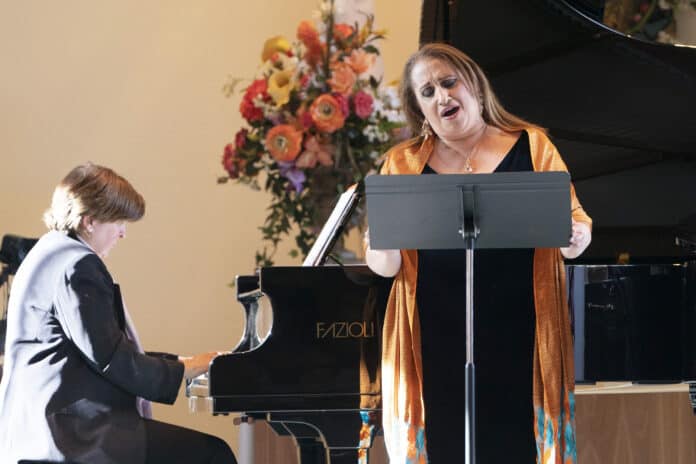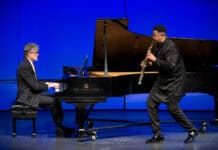
The eighth annual Piano on the Rocks festival returned to the Sedona United Methodist Church over the weekend of May 5 to 7 with two pianos, four pianists and a transcontinental assortment of musical talent.
“The rocks are sonorous,” festival director Sandrine Erdely-Sayo said. “It’s like being in a musical theatre.”
Friday’s program featured selections by Johann Sebastian Bach and Wolfgang Amadeus Mozart, followed by three of Franz Liszt’s settings of Petrarch’s sonnets. Works by Kurt Weill and Sergei Rachmaninoff rounded out the day’s offerings.
Saturday
Saturday’s concert began with an unscheduled performance of Leonard Cohen’s “Hallelujah” by Erdely-Sayo and Madeline Hehn, accompanied by sopranos Sara Catarine and Sonja Bruzauskas.
Next, David Saliamonas introduced three Spanish dances by Engrique Granados and three Argentine dances by Alberto Ginastera.
“It’s pretty easy music to listen to, so I don’t really need to explain anything,” Saliamonas joked with the audience before delivering an energetic attack on Granados’ dances, some of which sounded more boogie-woogie than Spanish. He rendered them with an intensity that was sometimes in contrast with their languor, playing with his entire upper body. Ginastera’s “Dance of the Outlaw Cowboy” was not just a rush for the audience with its speed and hint of saloon, but also the occasion for a dazzling technical display that drew one of the loudest ovations of the weekend from the listeners.
Catarine joined Saliamonas to present four songs by Jaime Leon Ferro, a composer from her homeland of Colombia. “A ti” gave her the chance to show both great depth of feeling and lovely control in the pianissimo passages, while “Algun dia” combined vintage mid-century feeling with a striking diminuendo in its conclusion. Catarine followed up the Colombian pieces with an excerpt from Inocente Carreno’s “Five Senses” song cycle discussing Paris, a sweetly-languishing piece that was an excellent example of a sensory theme being translated into sound.
Erdely-Sayo returned to the keyboard for Isaac Albeniz’s “Sevilla,” a bright cascade of sounds that was soft and lively, confident and unsure, playful and assertive by turns, and Primitivo Lazaro’s “Rapsodia Onubense,” which was full of ideas. Catarine accompanied her to finish off the first half of the afternoon with another surprise, Lazaro’s “Lagrimas por Granada,” an ominous and evocative dramatization of how Boabdil, the last emir of Granada, was cursed by his mother to weep forever for his lost land as a punishment for his cowardice.
The second half of the program began with Erdely-Sayo and Bruzauskas joining forces for Robert Schumann’s “Frauenliebe und Leben” song cycle about the typical male-centered romantic feelings of the typical Romantic heroine.
“What you are about to hear is very, very old-fashioned,” Bruzauskas told the crowd. “So how does any self-respecting modern woman perform this song cycle today?”
“We are telling the story of how things used to be,” Bruzauskas went on. “We must tell the story of the past. We have the responsibility of teaching history, and what better way of teaching history than through beautiful music?”
The eight songs of the cycle then took a grand tour through soft longing, quivering anticipation, alarm, contentment and accomplishment, uncertainty, swooning, overflowing enthusiasm and finally tragedy, ending in a prolonged slow demise that left the audience frozen.
Cynthia Raim rounded out the afternoon with a clear, precise rendition of Frederick Chopin’s “Sonata No. 3,” flowing effortlessly through his floods of notes. A mostly moody first movement gave way to a frisky, relaxed second, a tender third that mesmerized the listeners and a rollicking, rousing fourth.
“I have seldom heard such an interpretation,” Erdely-Sayo declared afterward. “A superb gift. An honor.”
Sunday
Sunday’s selections began with Erdely-Sayo’s own composition “The Best of Me is You,” a birthday tribute to her mother, who was also her first piano teacher and who was present in the front row of the audience. Afterward, Raim joined Erdely-Sayo to deliver Chopin’s “Rondo for two pianos,” which was energetic, acrobatic and featured the occasional hint of Beethoven. It also gave the listeners a fascinating chance to watch the two pianists communicating both with and without sound.
As Sunday was also the anniversary of Johannes Brahms’ birthday, Raim offered three short pieces of what she called Brahms’ “soul music.” The first of these was gentle and reflective, the second inquisitive and relaxed and the third sober and reflective.
Next, Saliamonas delivered another Schumann song cycle, “Scenes from Childhood.” “I’m not going to talk about all of these,” he confided in the crowd before talking about almost all of the pieces, which he then performed with enthusiasm and absorption. As for Schumann, he would have done better to include less fright and reverie and more knight on a hobbyhorse in the work.
Intermission was followed by Erdely-Sayo and Catarine with “Dudele,” a setting of a Hasidic prayer by Anna Rubin that blended both operatic and Yiddish elements, and several songs by Francis Poulenc. “Violin” effectively conjured up an image of the smoky wartime cafes of occupied France; “Pablo Picasso” was vigorous and intense, giving Catarine’s voice room to express its power.
Catarine and Bruzauskas combined forces with Hehn at the keyboard to present Leo Delibes’ “Les trois oiseaux” and the Flower Duet from his opera “Lakme,” two pieces that highlighted the strength of their harmonizing skills and filled the sanctuary with song.
Franz Schubert’s “Wanderer Fantasy” was Erdely-Sayo’s last choice for the festival. After reminding the crowd that it was usually considered Schubert’s most technically-demanding composition, she matched its pyrotechnics with a driving force of her own. Both the first and fourth movements of the fantasy strongly echo Beethoven’s piano technique, particularly the latter’s Emperor Concerto, almost as if Schubert had wanted to write a Beethoven piano concerto but couldn’t quite make up his mind to do so.
Finally, all four pianists combined at one keyboard to dare Albert Lavignac’s “Gallop March” for eight hands, to the disbelief and then the delight of the audience.
“Anyone want to come up and help us?” Saliamonas offered. “There’s room.”
That may have been a slight exaggeration, but there was still enough room for the four pianists to close the festival with a collective blast of high spirits.
“Find someone and bring them to the concert,” festival president Sherri Anderson had urged the audience on the second day, reminding them that the performances are purposefully free. “Music, as it blesses you, blesses everyone.”


















